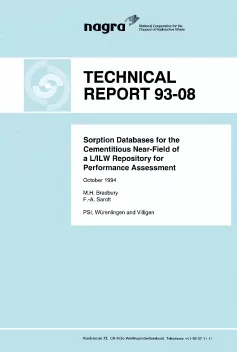
Technical Report NTB 93-08
Sorption Databases for the Cementitious Near-Field of a UILW Repository for Performance Assessment
Approximately 95 weight per cent of the material in the L/ILW repository for short-lived low- and intermediate-level wastes consists of concrete; the remaining approx. 5 % consists of steel (4 %) and high molecular weight organic waste components (1 %). Radionuclide sorption onto concrete represents one of the most important retardation mechanisms in the disposal caverns. This report compiles the sorption properties of hydrated cement, the most important sorbing material present in concrete, in the form of data sets for safety relevant nuclides under repository conditions; these data can then be used directly in performance assessment.
In the disposal caverns, the cement is affected by a range of different processes which can influence the sorption of radionuclides. External processes include the leaching of the cement by inflowing groundwater, while internal processes include dissolution of repository components in the cement pore water; these components can react with radionuclides and thus alter their sorption behaviour or they can react with the cement and alter its leaching properties.
Processes which affect sorption onto cement in the disposal caverns are documented in different data sets in this report. Degradation (leaching) of cement is described in three characteristic degradation steps and the redox state of the cement is accounted for by assuming two extremes (oxidising and reducing). The effects of complexants are presented for 10 material groups. Half of these groups consist of different high molecular weight organic compounds which are present in high concentrations in the waste and decompose to low molecular weight compounds in the caverns. Besides these 5 groups, 5 low molecular weight compounds are considered; these are either present in large volumes or have a large complexation capacity with respect to nuclides.
In this report, the distribution coefficients for radionuclides on cement are based to a large extent on values measured under repository-relevant conditions; this is true for cement without complexants in particular. The selection of the distribution coefficients is justified on the basis of the original studies carried out, thus ensuring transparent derivation of the data. Where data are lacking, the assumptions made are clearly documented. In the case of safety relevant nuclides for which there are no published values at present, the distribution coefficients were selected on the basis of chemical analogy with other elements.
